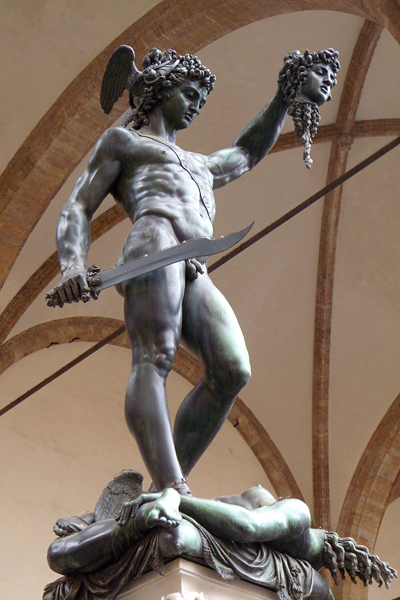
"Along the way, in fields and by the roads, I saw on all sides men and animalsólike statuesóturned to flinty stone at sight of dread Medusa's visage. Nevertheless reflected on the brazen shield, I bore upon my left, I saw her horrid face. When she was helpless in the power of sleep and even her serpent-hair was slumber-bound, I struck, and took her head sheer from the neck."
Ovid, Metamorphoses (IV.770ff)
"...I would be only too pleased to make him a great statue, either in marble or bronze, for that fine piazza of his. He [Cosimo I de Medici] answered that all he wanted as my first work for him was a Perseus; he had been wanting this for a long time, and he begged me to make him a little model of it....'My dear Benvenuto, if you produce a large work which is as excellent as this little model it will be the finest work on the piazza.' 'Your Excellency,' I replied, 'there are works on the piazza by the great Donatello [Judith and Holofernes], and by the marvellous Michelangelo [David], and these two men have proved themselves the greatest artists since the time of the ancients. But as your most Illustrious Excellency is very enthusiastic about my model let me say that I have it in me to produce a work that will be three times better still.'"
Cellini: The Autobiography (LIII)
Donatello's bronze statue of Judith and Holofernes takes its theme from the apocryphal Judith, one of the Deuterocanonical books of the Bible. It narrates how the beautiful and pious widow beguiles and then decapitates her enemy Holofernes, a general of Nebuchadnezzar who has laid siege to the town.
"So every one went out, and no one, either small or great, was left in the bedchamber. Then Judith, standing beside his bed, said in her heart, 'O Lord God of all might, look in this hour upon the work of my hands for the exaltation of Jerusalem. For now is the time to help thy inheritance, and to carry out my undertaking for the destruction of the enemies who have risen up against us.' She went up to the post at the end of the bed, above Holofernes' head, and took down his sword that hung there. She came close to his bed and took hold of the hair of his head, and said, 'Give me strength this day, O Lord God of Israel!' And she struck his neck twice with all her might, and severed it from his body. Then she tumbled his body off the bed and pulled down the canopy from the posts; after a moment she went out, and gave Holofernes' head to her maid, who placed it in her food bag. Then the two of them went out together, as they were accustomed to go for prayer; and they passed through the camp and circled around the valley and went up the mountain to Bethulia and came to its gates. Judith called out from afar to the watchmen at the gates, 'Open, open the gate! God, our God, is still with us, to show his power in Israel, and his strength against our enemies, even as he has done this day!' When the men of her city heard her voice, they hurried down to the city gate and called together the elders of the city. They all ran together, both small and great, for it was unbelievable that she had returned; they opened the gate and admitted them, and they kindled a fire for light, and gathered around them. Then she said to them with a loud voice, 'Praise God, O praise him! Praise God, who has not withdrawn his mercy from the house of Israel, but has destroyed our enemies by my hand this very night!' Then she took the head out of the bag and showed it to them, and said, 'See, here is the head of Holofernes, the commander of the Assyrian army, and here is the canopy beneath which he lay in his drunken stupor. The Lord has struck him down by the hand of a woman.'" (Judith 13:3-15).
Given the civic identity evoked by the sculpture gallery in the Loggia dei Lanzi, it is perhaps not surprising that Donatello's bronze statue of Judith and Holofernes (1460), who had been struck down "by the hand of a woman," first was countered by the Perseus and then displaced altogether by the Rape of the Sabine Women. It was moved from the west arch, where it had been been since 1506, to the south arch, away from the Piazza della Signoria, and then to the Palazzo Vecchio, where it now is in the museum.
The Perseus has been sheltered beneath the east arch of the Loggia dei Lanzi in the Piazza della Signoria (Florence) since 1554, when the statue was completed. The original bronze statues of Mercury, Minerva, Jupiter and DanaŽ (the mother of Perseus) in the niches of the marble base are in the Museo Nazionale del Bargello.
References: Benvenuto Cellini: The Autobiography (1956) translated by George Bull (Penguin Classics). The Metamorphoses of Ovid (1955) translated by Mary M. Innes (Penguin Classics).